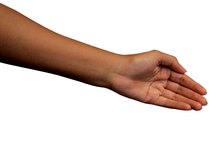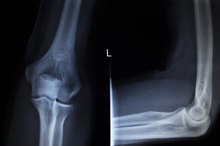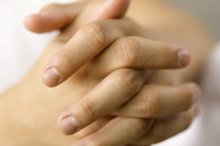Stretches for the Ulnar Nerve
Ulnar nerve pain can make it difficult to do the simplest activities. Pain in the hand and fingers can make life pretty unpleasant. The ulnar nerve branches off from the brachial plexus and runs down through the forearm and into the hand, innervating the ring and pinky fingers. If you are suffering from ulnar nerve pain, there are some simple stretches that you can do to improve pain and function.
Causes
There are several reasons why you may be feeling pain in your fingers from your ulnar nerve. All of the conditions result from ulnar nerve entrapment, meaning that the nerve is being compressed. These conditions include ulnar tunnel syndrome, cyclist's palsy and bowler's thumb. Management of these conditions includes relieving the pressure on the nerve. This is done by stretching the muscles that surround it. Tight muscles can lead to nerve compression, so keeping them flexible can help.
- There are several reasons why you may be feeling pain in your fingers from your ulnar nerve.
- All of the conditions result from ulnar nerve entrapment, meaning that the nerve is being compressed.
Hyperextension
Tingly Feeling When Doing Pull-Ups
Learn More
Extension is considered when your hand is straight out and the wrist is not bent. To feel a stretch in your forearm and hand where the ulnar nerve runs, you must hyperextend your wrist. To do this, place your palms together in a prayer position; hold this stretch for at least 20 seconds.
Radial Deviation
This stretch is a frontal plane movement that involves the flexor carpi radialis and the extensor carpi radialis, both muscles of the forearm. To do this stretch, keep your hand straight out in front of you with your wrist extended, not bent. Slowly move your hand toward the middle of your body, then return it to start position.
Ulnar Deviation
Arm Stretches on the Wall for the Median Nerve
Learn More
Ulnar deviation is the opposite movement of radial deviation. This stretch uses the flexor carpi ulnaris and extensor carpi ulnaris, both muscles of the forearm that work the wrists. With your hands in front of you and your wrists extended, move your hands away from the middle of your body at the wrists.
Considerations
When you perform these stretches, be sure to hold each one for at least 20 seconds. Stretches can be done two to three times daily. These stretches should not cause you pain. If you are unsure about what you are doing, it may benefit you to see your doctor. He can give you specific exercises for your condition.
- When you perform these stretches, be sure to hold each one for at least 20 seconds.
- He can give you specific exercises for your condition.
Related Articles
References
- "Anatomy and Physiology"; Saladin, Kenneth S.; 2004
- "Foundations of Athletic Training"; Anderson, Marcia K., Hall, Susan J., Martin, Malissa; 2005.
- Conti MS, Camp CL, Elattrache NS, Altchek DW, Dines JS. Treatment of the ulnar nerve for overhead throwing athletes undergoing ulnar collateral ligament reconstruction. World J Orthop. 2016;7(10):650-656. doi:10.5312/wjo.v7.i10.650
- MedlinePlus. Ulnar nerve dysfunction. Updated April 30, 2018.
- American Academy of Orthopaedic Surgeons. Ulnar nerve entrapment at the elbow (cubital tunnel syndrome).
- Depukat P, Henry BM, Popieluszko P, et al. Anatomical variability and histological structure of the ulnar nerve in the Guyon's canal. Arch Orthop Trauma Surg. 2017;137(2):277-283. doi:
- Cleveland Clinic. Thoracic outlet syndrome (TOS). Updated July 29, 2019.
- Goldman SB, Brininger TL, Schrader JW, Curtis R, Koceja DM. Analysis of clinical motor testing for adult patients with diagnosed ulnar neuropathy at the elbow. Arch Phys Med Rehabil. 2009;90(11):1846-52. doi:10.1016/j.apmr.2009.06.007
- Robinson S, Ng CY. Traction Tinel sign. J Hand Microsurg. 2016;8(2):125-6. doi:10.1055/s-0036-1586139
- Woo A, Bakri K, Moran SL. Management of ulnar nerve injuries. J Hand Surg Am. 2015;40(1):173-81. doi:10.1016/j.jhsa.2014.04.038
- Dy CJ, Mackinnon SE. Ulnar neuropathy: evaluation and management. Curr Rev Musculoskelet Med. 2016;9(2):178-84. doi:10.1007/s12178-016-9327-x
- Kim KH, Lee SJ, Park BK, Kim DH. Sonoanatomy of sensory branches of the ulnar nerve below the elbow in healthy subjects. Muscle Nerve. 2018 Apr;57(4):569-573. DOI: 10.1002/mus.25959.
- Said J, Van Nest D, Foltz C, Ilyas AM. Ulnar Nerve In Situ Decompression versus Transposition for Idiopathic Cubital Tunnel Syndrome: An Updated Meta-Analysis. J Hand Microsurg. 2019 Apr;11(1):18-27. DOI: 10.1055/s-0038-1670928.
Resources
Writer Bio
Laura Niedziocha began her writing career in 2007. She has contributed material to the Stoneking Physical Therapy and Wellness Center in Lambertville, N.J., and her work has appeared in various online publications. Niedziocha graduated from Temple University with a Bachelor of Science in exercise science. She also has her Associate of Arts in communications from the Community College of Philadelphia.









